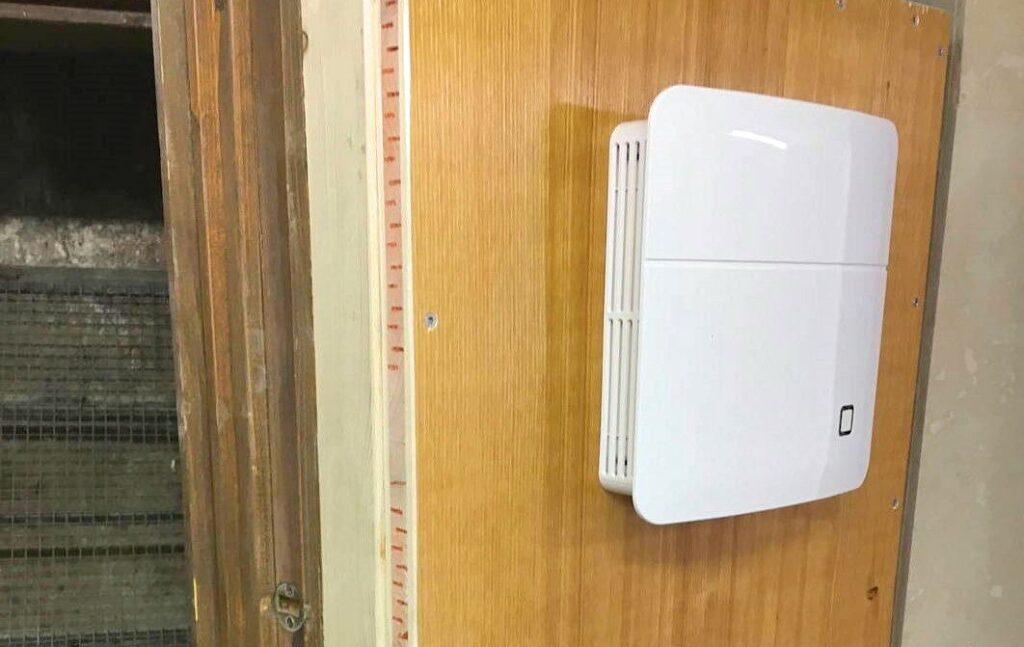Radon ventilation
Would you like to reduce the radon concentration in the basement to a harmless level and improve the indoor climate at the same time? We install intelligent basement ventilation systems.

Homepage › Radon ventilation
Radon ventilation system
According to the Federal Office for Radiation Protection (BfS), inhalation of radon is [2.] is the most common cause of lung cancer after smoking. For this reason, the Radiation Protection Act obliges homeowners and builders to comply with certain rules regarding radon in new buildings and renovations.
For example, the radon concentration in living and recreation rooms must not exceed the threshold value of 300 becquerels per cubic meter. If the concentration is above this value, countermeasures must be taken. An effective and probably the most cost-effective measure against radon in the home is the installation of a radon ventilation system [3.]. We install radon ventilation systems. Ask us without obligation.
The radon risk is particularly high in buildings located in an area with high radon contamination (cf. Radon map below); in buildings without a continuous concrete foundation and in buildings built before 1960 that have neither moisture protection nor external insulation. In general, the risk of high radon concentrations is highest in rooms in contact with the ground.
If you want to find out the radon concentration in your building, you can order passive radon measuring devices from a recognized measuring body, set them up in the building for three to twelve months and then have them evaluated by the measuring laboratory [4.].
⇓ "Radon Handbook Germany" (status 2019) of the Federal Office for Radiation Protection BfS
Our services
- Radon short-term measurement, if desired
- Installation of radon ventilation
- Re-measurement, if desired
Your advantages
- Advice from experienced civil engineers or building biologists
- Effective and inexpensive protection against radon in the building
- Noticeable improvement of the indoor climate
- Minimizing the risk for mold and moisture damage

Radon in homes in Germany [5.]Estimation of the radon concentration in living spaces, interactive map

Contact us without obligation
Do you have any further questions or may we prepare an offer for you?
Get in touch with us without obligation. We look forward to your inquiry!
Get in touch with us without obligation. We look forward to your inquiry!
Tobias Bayer
Managing Director

Questions & Answers
- General
- Costs
- Functionality
- Radon hazard
- Implementation
What is radon ventilation?
Radon ventilation is an automatic ventilation system with heat recovery that is installed in radon-contaminated cellars. In addition to lowering the radon concentration, it dehumidifies and improves the indoor climate. This can also have a positive effect on the indoor climate on the floors above. The fans are very quiet and economical in consumption.
What is the cost of radon ventilation for the basement?
We install humidity or time-controlled ventilation units with heat recovery from EUR 2,200. The actual price is determined by the size of the cellar, the ventilation unit, the cost of installation and the time it takes us to get there. Basement ventilation offers effective protection against radon and is also the most cost-effective measure against radon in buildings. Order a non-binding offer now
How does the radon ventilation work?
A humidity or time-controlled ventilation unit with integrated heat recovery automatically ensures continuous ventilation of the cellar. The constant exchange of air prevents radon concentrations from building up and also improves the indoor climate.
Who is Haustrocknung.de?
How much does a radon ventilation system cost?
Haustrocknung.ch installs effective basement ventilation systems to protect against radon from EUR 2,200. The price depends on the cost of installation, the ventilation unit and the duration of the journey. We will be happy to prepare an individual offer for you.
What is the annual electricity cost of radon ventilation?
The electricity costs of Radon ventilation amount to EUR 25 per year. Our high-quality ventilation systems have multi-stage adjustable operation with humidity or time control and heat recovery as well as a maximum power consumption of 6 watts.
How does radon ventilation affect heating costs?
What are the maintenance costs and expenses?
How does radon ventilation work?
Radon ventilation ensures a continuous exchange of the room air volume in the basement. This reliably prevents the accumulation of radon in the rooms. In addition, automated ventilation minimizes the risk of mould and moisture damage while at the same time noticeably improving the indoor climate.
How effective is ventilation in reducing radon concentrations?
According to the Federal Office of Public Health FOPH the ventilation of cellar rooms is an effective measure for reducing radon concentrations. To be on the safe side, a radon measurement should be carried out following the installation of basement ventilation. In our experience, basement ventilation provides effective protection against radon and is also the most cost-effective measure against radon in the home.
How is the ventilation controlled?
Basement ventilation basically controls itself via e.g. the humidity sensors. Alternatively, the ventilation unit can also be operated via remote control.
What can the radon ventilation do?
Radon ventilation is a humidity or time-controlled basement ventilation system with heat recovery and integrated filter. It ventilates in and out in both directions and primarily leads to a continuous exchange of room air and a reduction in humidity. This results in a noticeable improvement in the indoor climate. Musty odors are reduced or disappear completely, and the risk of mould is reduced to almost zero.
Why can radon be dangerous in the basement?
Radon is a radioactive gas that has been proven to increase the risk of lung cancer if inhaled. The gas is produced by the natural decay of uranium, which is found in soil and rocks. It enters the basement through cracks and leaks in the ground, where it accumulates if there is insufficient ventilation.
Which buildings are at increased risk of radon?
Buildings in areas with high radon concentrations are particularly at risk (see Radon map of the BAG); buildings without a continuous concrete foundation; buildings that were built before 1960 and have neither external insulation nor moisture protection, as well as all cellar rooms in which people are present.
How can I measure the radon concentration in the house?
According to the Federal Office of Public Health FOPH radon can be measured easily and inexpensively by means of so-called «dosimeters», which you can order from a recognized radon measuring station. The measurement should be carried out in addition to the basement in two separate living spaces with longer residence times, whereby the measurement period must extend over at least three months during the heating period.
What radon concentrations are considered safe or harmful?
The Federal Radiation Protection Ordinance has stipulated a reference value of 300 becquerels per cubic meter for radon concentrations in living and recreation rooms since 2018. Concentrations of the noble gas that are below this threshold are considered harmless. However, inhalation of radon should be avoided at all costs.
When is radon ventilation required?
According to the Federal Radiation Protection Ordinance, countermeasures must be taken from a radon concentration of 300 becquerels per cubic meter. Radon ventilation is an effective and at the same time the most cost-effective measure against radon in buildings. Apart from reducing the radon concentration, it has a noticeably positive effect on the indoor climate.
Where do you install the radon ventilation?
The ventilation units are very quiet and can be installed both in the cellar and in the living room. They can be installed in windows, light wells or by drilling a core hole at a suitable point in the outside wall. After inspecting the rooms concerned, we will make you a proposal for the installation of the ventilation system. Contact us without obligation.
What should be considered in terms of installation?
For the installation, we need to access the ventilation from inside and outside. Depending on the height and location of the premises, a lifting platform may be required.
How long does it take to install the ventilation?
Radon ventilation installation usually takes between half a day and a full day.
Sources (in German)
- Federal Ministry for the Environment, Nature Conservation, Nuclear Safety and Consumer Protection BMUV - Radon
- Federal Office for Radiation Protection BfS - Radon
- Federal Office for Radiation Protection BfS - Protective measures: What can I do? What must I do?
- Bundesamt für Strahlenschutz BfS - How can I measure radon (or have it measured)?
- Federal Office for Radiation Protection BfS - Radon in homes in Germany